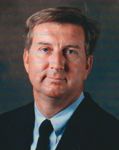Article
Viewpoint: Pondering getting rich (and thin)
A few years ago, I reached the age that men reach when they can no longer eat whatever they want and stay the same weight and remain fit.

One problem for me is that running, or exercising for the sake of fitness, never has been appealing. My preference is for activities that don't seem like exercise. Examples include surfing (which is about fun), skiing black diamonds (which is about terror), and golfing (which is about cursing, driving the cart, and enjoying the 19th hole).
During the cold, winter months in the mid-Atlantic states, however, using a treadmill, elliptical machine, and similar indoor exercise equipment is necessary. My strategy is to find something distracting to read or watch and take my mind off the boring exercise. Recently, while sweating away on my machine, I watched an episode of CNBC's financial show, "Mad Money."
The American Society of Hematology (ASH) meeting was taking place in New Orleans that weekend, he explained, and four companies would be presenting the results of their clinical trials. Showing the symbols (ALTH, CELG, IMGN, and ONXX) and recent price activity of each stock, Cramer briefly described each of the treatments in development. The findings from the trials were being unveiled at the ASH meeting, and he expected them to be positive. For example: "Onyx [the company whose symbol is ONXX] should give-count 'em-15 solid presentations."
Cramer recommended purchasing the stocks of these companies. A few questions came to mind as I watched the program:
1. If these results are being presented for the first time at this ASH meeting, how did he already know the results would be positive?
2. If he is accurate, shouldn't it be possible to get the latest results of clinical trials by watching shows like this instead of traveling to meetings?
3. Can I get CME credits for watching shows like this while working on maintaining my girlish figure?
4. Have I burned 1,000 calories yet?
5. Could I make a killing by buying these stocks while exercising? (They say you can never be too thin or too rich.)
'Promising' results?
My curiosity was piqued, and a few days later I went online to look up news about these four new putative therapies. For three of the four, news articles described the results presented as "positive," "promising," or "encouraging." One of the four was "disappointing."
As far as the getting rich part, the stock prices of all four companies had dropped, with the decline ranging from 1% to 13% (in the company whose study proved "disappointing"). My lack of sophistication about the stock market prevented me from understanding why the announcement of positive results should result in a drop in the stock's price unless the results were somehow already known.
I still think my plan-shrinking the old waistline on the elliptical machine while watching stock shows and fattening my wallet through investments based upon clinical trial results that are yet to be revealed-is a brilliant one.
Also, it is distracting and keeps the mind off the exercise part. But there may be some subtle flaw in this plan. Further research and exercise are necessary.

By Peter J. McDonnell, MD director of the Wilmer Eye Institute, Johns Hopkins University School of Medicine, Baltimore, and chief medical editor of Ophthalmology Times.
He can be reached at 727 Maumenee Building 600 N. Wolfe St. Baltimore, MD 21287-9278 Phone: 443/287-1511 Fax: 443/287-1514
E-mail: pmcdonn1@jhmi.edu
Newsletter
Don’t miss out—get Ophthalmology Times updates on the latest clinical advancements and expert interviews, straight to your inbox.




